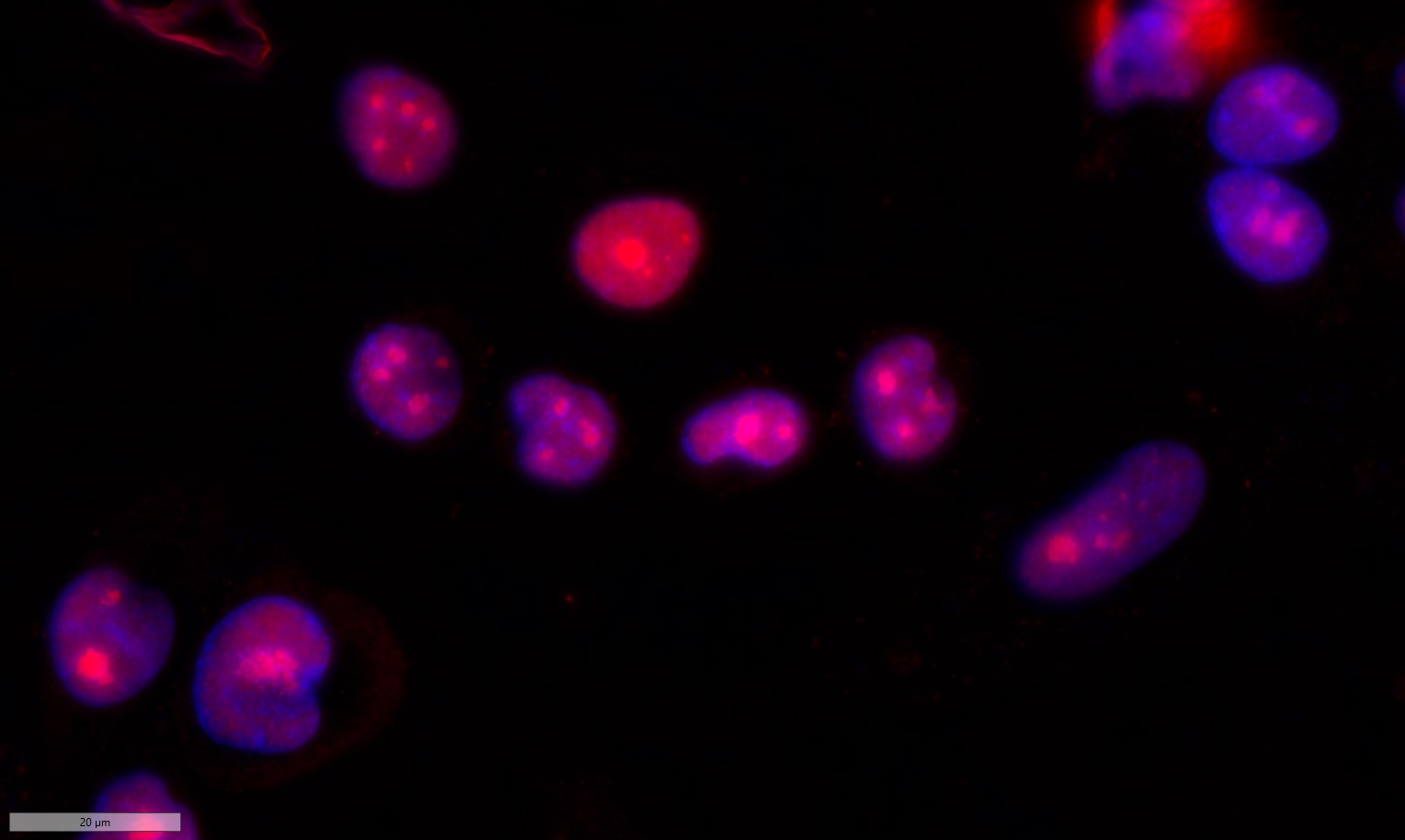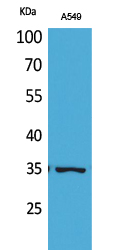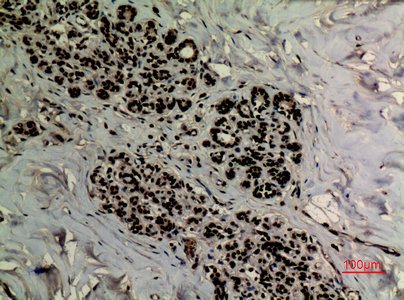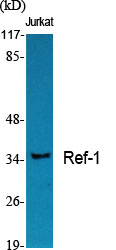Ref-1 (Acetyl Lys6) Polyclonal Antibody
- Catalog No.:YK0022
- Applications:WB;IHC;IF;ELISA
- Reactivity:Human;Rat;Mouse;
- Target:
- Ref-1
- Fields:
- >>Base excision repair
- Gene Name:
- APEX1
- Protein Name:
- DNA-(apurinic or apyrimidinic site) lyase
- Human Gene Id:
- 328
- Human Swiss Prot No:
- P27695
- Mouse Swiss Prot No:
- P28352
- Immunogen:
- The antiserum was produced against synthesized Acetyl-peptide derived from human APE1 around the Acetylation site of Lys6. AA range:1-50
- Specificity:
- Acetyl-Ref-1 (K6) Polyclonal Antibody detects endogenous levels of Ref-1 protein only when acetylated at K6.
- Formulation:
- Liquid in PBS containing 50% glycerol, 0.5% BSA and 0.02% sodium azide.
- Source:
- Polyclonal, Rabbit,IgG
- Dilution:
- WB 1:500 - 1:2000. IHC: 1:100-300 ELISA: 1:20000.. IF 1:50-200
- Purification:
- The antibody was affinity-purified from rabbit antiserum by affinity-chromatography using epitope-specific immunogen.
- Concentration:
- 1 mg/ml
- Storage Stability:
- -15°C to -25°C/1 year(Do not lower than -25°C)
- Other Name:
- APEX1;APE;APE1;APEX;APX;HAP1;REF1;DNA-(apurinic or apyrimidinic site) lyase;APEX nuclease;APEN;Apurinic-apyrimidinic endonuclease 1;AP endonuclease 1;APE-1;REF-1;Redox factor-1
- Observed Band(KD):
- 35kD
- Background:
- Apurinic/apyrimidinic (AP) sites occur frequently in DNA molecules by spontaneous hydrolysis, by DNA damaging agents or by DNA glycosylases that remove specific abnormal bases. AP sites are pre-mutagenic lesions that can prevent normal DNA replication so the cell contains systems to identify and repair such sites. Class II AP endonucleases cleave the phosphodiester backbone 5' to the AP site. This gene encodes the major AP endonuclease in human cells. Splice variants have been found for this gene; all encode the same protein. [provided by RefSeq, Jul 2008],
- Function:
- catalytic activity:The C-O-P bond 3' to the apurinic or apyrimidinic site in DNA is broken by a beta-elimination reaction, leaving a 3'-terminal unsaturated sugar and a product with a terminal 5'-phosphate.,function:Repairs oxidative DNA damages in vitro. May have a role in protection against cell lethality and suppression of mutations. Removes the blocking groups from the 3'-termini of the DNA strand breaks generated by ionizing radiations and bleomycin.,similarity:Belongs to the DNA repair enzymes AP/exoA family.,subunit:Monomer. Component of the SET complex, which also contains SET, ANP32A, HMGB2 and NME1.,
- Subcellular Location:
- Nucleus. Nucleus, nucleolus. Nucleus speckle. Endoplasmic reticulum. Cytoplasm. Detected in the cytoplasm of B-cells stimulated to switch (By similarity). Colocalized with SIRT1 in the nucleus. Colocalized with YBX1 in nuclear speckles after genotoxic stress. Together with OGG1 is recruited to nuclear speckles in UVA-irradiated cells. Colocalized with nucleolin and NPM1 in the nucleolus. Its nucleolar localization is cell cycle dependent and requires active rRNA transcription. Colocalized with calreticulin in the endoplasmic reticulum. Translocation from the nucleus to the cytoplasm is stimulated in presence of nitric oxide (NO) and function in a CRM1-dependent manner, possibly as a consequence of demasking a nuclear export signal (amino acid position 64-80). S-nitrosylation at Cys-93 and
- Expression:
- Brain,Embryonic stem cells,Lung,Melanocyte,Placenta,Skin,
- June 19-2018
- WESTERN IMMUNOBLOTTING PROTOCOL
- June 19-2018
- IMMUNOHISTOCHEMISTRY-PARAFFIN PROTOCOL
- June 19-2018
- IMMUNOFLUORESCENCE PROTOCOL
- September 08-2020
- FLOW-CYTOMEYRT-PROTOCOL
- May 20-2022
- Cell-Based ELISA│解您多样本WB检测之困扰
- July 13-2018
- CELL-BASED-ELISA-PROTOCOL-FOR-ACETYL-PROTEIN
- July 13-2018
- CELL-BASED-ELISA-PROTOCOL-FOR-PHOSPHO-PROTEIN
- July 13-2018
- Antibody-FAQs
- Products Images

- Immunofluorescence analysis of Siha cell. 1,primary Antibody was diluted at 1:100(4°C overnight). 2, Goat Anti Rabbit IgG (H&L) - AFluor 594 Secondary antibody(catalog No: RS3611) was diluted at 1:500(room temperature, 50min).

- Western Blot analysis of A549 cells using Acetyl-Ref-1 (K6) Polyclonal Antibody. Secondary antibody(catalog#:RS0002) was diluted at 1:20000
.jpg)
- Western Blot analysis of A549 cells using Acetyl-Ref-1 (K6) Polyclonal Antibody. Secondary antibody(catalog#:RS0002) was diluted at 1:20000
.jpg)
- Immunohistochemical analysis of paraffin-embedded human-breast, antibody was diluted at 1:100

- Immunohistochemical analysis of paraffin-embedded human-breast, antibody was diluted at 1:100

- Western blot analysis of lysate from A549 cells, using APE1 (Acetyl-Lys6) Antibody.


